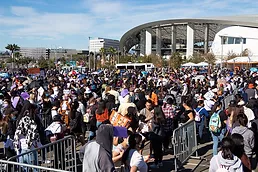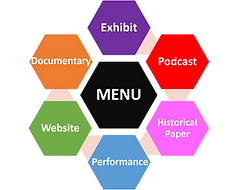Research Project: Koreans and Korean Americans in the U.S. Economy after 1992

Individually, in pairs, or small groups, students create a culminating project that demonstrates their understanding of the impacts of Koreans and Korean Americans in the US Economy after 1992, as well as connections to their family, community, and Korean American history. There are six options; these options are aligned with California/National History Day. Some options may be completed as a pair or small group; others are individual only.
Fans queueing to buy BTS merchandise before a concert in Los Angeles in 2021. (Source: Wikipedia)
Activity Questions
-
How have Koreans and Korean Americans contributed to the US economy since 1992?
-
How will I demonstrate what I have learned and its connections to my family, community, and Korean American history?
Instructional Strategies
-
There is no presentation to accompany this activity.
Park Essay: Koreans and Korean Americans in the US Economy after 1992
-
Distribute the Park Essay (download below) and assign students to read and annotate the Park Essay. (This could be completed as a homework assignment.)
-
Have students quickwrite to the following prompt:
-
Since 1992, Koreans and Korean Americans have contributed to the world-wide and US economy in significant ways. Identify two contributions and explain how these contributions are uniquely Korean and Korean American. Be prepared to share.
-
-
Select students to share answers with the class.
-
Divide students into groups of 4-5 and have them complete the first four questions on the Park Essay Worksheet (download below).
-
Have students answer questions 5 and 6 on their own. Divide students into new groups (i.e., students must be in a new group with no more than one person from their previous group) and have them share their answers to questions 4, 5, and 6.
-
Have each group tally the answers (for either or both questions) and then tally for the full class. Ideally, tally all answers; alternatively, have each group identify the top 3-5 answers. The goal of tallying answers is for the teacher and students to see the diversity (or lack of it) of possible project ideas.
Introduction to Project
-
For the Korean American History Project, students will choose one of six options aligned with California/National History Day. Some options may be completed as a pair; others are individual only.
-
Plan one day weekly for the next 8 weeks to provide support for project completion.


-
Present the Korean American History Project and explain that it will be completed over an 8-week timeline (show an updated timeline with your deadlines), with the first assignment to identify a project thesis statement and category. Distribute the Korean American History Project Menu Options (download below). Review the basics of each category and show examples from the History Day Website. In small groups or as a class, ask students to share what project category they like, and why. This will help students identify others to partner with.
-
Assign the Project Title, Thesis Statement, Category, and Group Members Worksheet (download below). Identify the due date for this assignment. and provide time in class for students to begin work during class. Ask for students to share their progress at the end of class.
Project Category Planning Worksheet
-
On the day of the deadline, collect, review, and provide feedback on the Project Title, Theme, Category, and Group Members Worksheet.
-
Assign the Project Category Planning Worksheets(s) (download below) based on project category selected. Identify the due date for this assignment. and provide time in class for students to begin work during class. Ask for students to share their progress at the end of class.
Annotated Bibliography
-
On the day of the deadline, collect, review, and provide feedback on the Project Planning Worksheet.
-
Assign the Annotated Bibliography and review the assignment by using the NHD Annotated Bibliography Guide (download below or from NHD Website). Explain what is required for the draft and what is required for the final assignment. Identify the due date for this assignment. and provide time in class for students to begin work during class.
Process Paper
-
On the day of the deadline, collect, review, and provide feedback on the Annotated Biography draft.
-
Assign the Process Paper Worksheet (download below) and review how to complete. Identify the due date for this assignment. and provide time in class for students to begin work during class.
NHD Project Checklist
-
On the day of the deadline, collect, review, and provide feedback on the Process Paper Worksheet.
-
Assign the appropriate NHD Project Checklist and review how to complete. NOTE: There may be items you don’t require, so check and identify as needed. Identify the due date for this assignment. and provide time in class for students to begin work during class.
Project Draft and NHD Scoring Guide/Rubric
-
On the day of the deadline, collect, review, and provide feedback on the NHD Project Category Checklists (download below or from NHD Website)).
-
On the day of the project draft deadline, collect, review, and provide feedback on students progress so far (this may review viewing video documentaries, listening to audio podcasts, reading papers and websites, and watching performances).
-
Let students know that on next deadline, a group of their peers will be assigned to provide a peer evaluation of their project using the NHD Scoring Guide/Rubrics (download below or from NHD Website). Have students review their project category scoring guide and make plans for any needed revisions (based on your review and the scoring guide). Identify the due date for this assignment. and provide time in class for students to begin work.
Final Deadline
-
Have students present their projects to the class and or an external audience. Use the NHD Scoring Guide /Rubrics (download below or from NHD Website) to assess student work.
-
Have students submit all written materials (Process Paper, Annotated Bibliography, etc.).
Resources
-
Word documents are linked below; PDF documents are shown below and are downloadable.
-
NHD Checklists and Scoring Guides (on the right) are linked to PDF documents on the California NHD Website.
Essay Assignment Resources
-
Essay: Koreans and Korean Americans in the US Economy after 1992. (John S.W. Park, Professor of Asian American Studies UC Santa Barbara, December 7, 2021) (PDF)
Project Resources
-
Korean American History Project Menu Options (PDF)
-
Project Title, Thesis Statement, Category, and Group Members Worksheet (Word)
Project Category Planning Worksheets
National History Day (NHD) Website Resources

-
NHD Multimedia Specialized Resources
-
NHD Checklists
-
NHD Podcast Checklist (not available at this time)
-
NHD Scoring Guide/Rubrics

